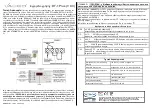
Operating Modes
1140
SPNU503C – March 2018
Copyright © 2018, Texas Instruments Incorporated
Multi-Buffered Serial Peripheral Interface Module (MibSPI) with Parallel Pin
Option (MibSPIP)
24.2.16 Continuous Self-Test (Master/Slave)
During data transfer, the SPI compares its own internal transmit data with its transmit data on the bus. The
sample point for the compare is at one-half SPI clock after transmit point. If the data on the bus does not
match the expected value, the bit-error (BITERR) flag is set and an interrupt is asserted if enabled.
NOTE:
The compare is made from the output pin using its input buffer.
24.2.17 Half Duplex Mode
SPI by protocol is Full Duplex in nature, which means simultaneous TX and RX operations happen on two
separate data pins, SIMO and SOMI. However, it is possible to use SPI/MibSPI to do the TX-only
operation (ignoring the RX data) and the RX-only operation (using dummy TX data and ignoring the TX
pin). But this requires that both SOMI and SIMO lines are bonded out in a chip to be able to support both
TX-only or RX-only features.
24.2.17.1 Half Duplex Mode in Master
The Half Duplex Mode gives an additional flexibility to use the SIMO pin, which is normally used as a TX
pin in Master mode, to work like an RX pin while the HDUPLEX_ENAx bit in SPIFMTx register is set to 1.
In Half Duplex Master mode, the SIMO pin acts as an RX pin. Switching between Full Duplex and Half
Duplex can be achieved using the SPIFMTx register being selected using the DFSEL bit of SPIDAT1
register or TXRAM locations.
24.2.17.2 Half Duplex Mode in Slave
In Half Duplex Slave mode, the SIMO pin, which is normally an RX pin, acts as a TX pin while the
HDUPLEX_ENAx bit in SPIFMTx register is set to 1. In Half Duplex Slave mode, the SIMO pin acts as a
TX pin. Switching between Full Duplex and Half Duplex can be achieved using the SPIFMTx register
being selected using the DFSEL bit of SPIDAT1 register or TXRAM locations.
24.3 Test Features
24.3.1 Internal Loop-Back Test Mode (Master Only)
The internal loop-back self-test mode can be utilized to test the SPI transmit and receive paths, including
the shift registers, the SPI buffer registers, and the parity generator. In this mode the transmit signal is
internally feedback to the receiver, whereas the SIMO, SOMI, and CLK pin are disconnected; that is, the
transmitted data is internally transferred to the corresponding receive buffer while external signals remain
unchanged.
This mode allows the CPU to write into the transmit buffer, and check that the receive buffer contains the
correct transmit data. If an error occurs the corresponding error is set within the status field.
NOTE:
This mode cannot be changed during transmission.
















































